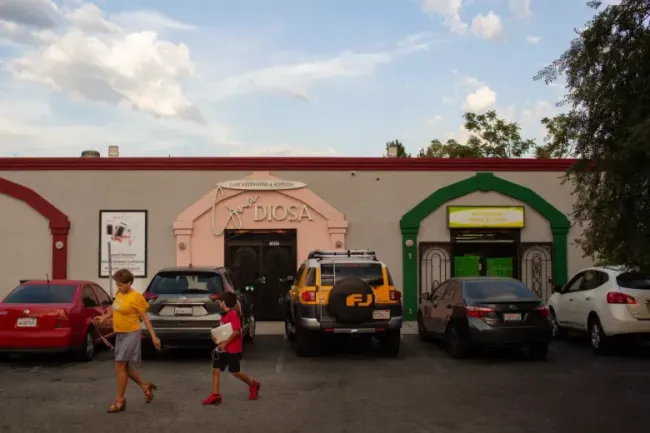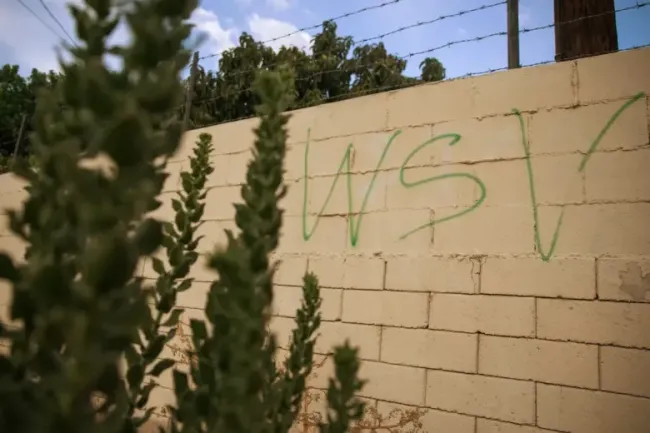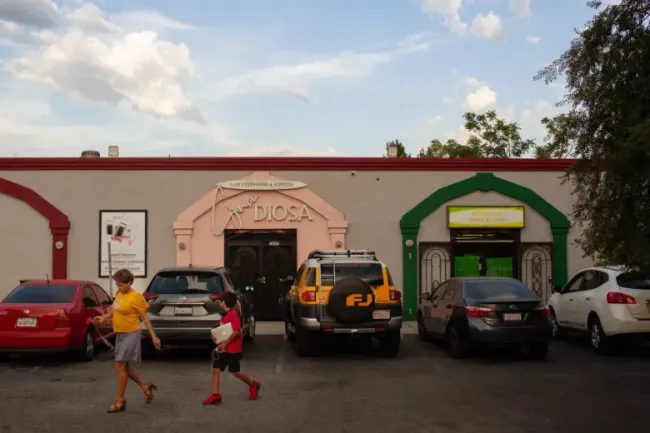Carmen Rodriguez obituary, Andrew Huero Verde leader Westside Verdugo street gang
Like something out of "Macbeth," the murder of a woman in Inland Empire reveals a power struggle among members of the Mexican Mafia.
In the parking lot of Gaby's Cafe, a hole-in-the-wall Mexican eatery in San Bernardino, a woman's body lay exposed to the rain.
The next day in the San Bernardino Sun, the murder received barely a brief mention: "The woman sustained several gunshot wounds to the upper body." After administering CPR, paramedics rushed the woman to safety in an ambulance.
Those who knew Carmen Rodriguez and her husband in January 2017 found her murder unfathomable. Andrew "Huero Verde" Rodriguez, her husband, was a member of the Mexican Mafia and the commander of the Westside Verdugo street gang. He was considered by many to be the most powerful figure in the San Bernardino underworld.
Authorities would later uncover that the murder of Carmen Rodriguez in Westside Verdugo was not the result of a marital argument or an isolated incident, but rather an assassination ordered by higher-ups in the Mexican Mafia and carried out by Rodriguez's henchmen.
This summer's trial of her alleged killer revealed one version of how Carmen Rodriguez was betrayed by her husband's men. It's still unclear if that was the whole truth. There were more questions than answers at the trial, despite the hundreds of pieces of evidence and dozens of witnesses.
The trial shed light on the immense influence the Mexican Mafia has over its gang members. Even though they called her "tia" and "mom" till her dying breath, Andrew Rodriguez's employees did not hesitate to carry out his order to murder his wife.
The 215 Freeway serves as a divider for the city of San Bernardino. To its east are the city's financial and judicial centers, as well as municipal and retail structures that have since closed. Some of the homes are neat and tidy, but others are strewn with trash and waste to the west. The Westside Verdugo community claims this area as its own.
According to Leo Duarte, a retired state prisons officer and Mexican Mafia expert who grew up on the west side of San Bernardino, the gang is founded in a collection of huge families who have lived in the neighborhood and pressed on with internecine feuds "through generations, through decades." And that's all they know. They were born and raised in the barrio, so they stayed.
In the past, the area's Latino residents could afford to live here thanks to the good wages offered by the Santa Fe railroad, Kaiser Steel, and Norton Air Force Base. All three businesses, however, either relocated or closed down between 1983 and 1994. Tens of thousands of positions disappeared.
According to Duarte, "after they shut down Kaiser, Santa Fe, and Norton, everything collapsed." He claimed that some families had to rely on welfare while others turned to criminal activity. He warned that a lack of economic growth, high unemployment, and a resulting increase in criminal activity would lead to these problems. "And what's the biggest con of all? Drugs.”
A lifelong Westside Verdugo resident testified at the trial of Carmen Rodriguez's accused killer, saying how his group, the Sur Crazy Ones, formed because some parents prioritized drugs over their children. As one member put it, "The Crazy Ones were originally a family."
Westside Verdugo, like most Latino gangs in SoCal, answers to the Mexican Mafia. Often referred to as a "gang of gangs," this group consists of over 140 men, almost all of whom are now behind bars. Together, they exercise authority over Latino gang members behind bars and levy fees on street gangs and drug traffickers.
Andrew Rodriguez, a hefty man with a beard and black spectacles, was initiated into the Mexican Mafia in his forties. This was approximately 2009. He had already served ten years of a life sentence for robbing a Sears and a sporting goods store in San Bernardino, his third felony conviction.

A detective testified during Rodriguez's trial that he had raided a house on the west side of San Bernardino and found a photograph of Rodriguez propped up on a shelf, with the black hand tattoo of the Mexican Mafia across his throat.
The Westside Verdugo gang has not had a member inducted into the Mexican Mafia for 15 years, making Rodriguez the first. His rise gave his crew an opportunity to leave their troubled background in the organization in the past.
Phillip "Chano" Chavez was the last of the Westside Verdugo gangsters to cross over to the Mexican Mafia. A San Bernardino police officer wrote in a letter seen by The Times that after Chavez's release from Pelican Bay State Prison in 1995, he returned to the area with the intention of avenging a previous wrong.
The document claims that Chavez had held a hatred against Johnny "Leche" Gutierrez, another gang member, since they were both teenagers. He thought Gutierrez had confessed to a robbery to the police, which is what got him committed to the California Youth Authority.
Gutierrez's nephew was killed by command of Chavez. According to the memorandum, Chavez ordered another Westside Verdugo member to kill his nephew after he refused to join the gang.
Three weeks later, on the west side of San Bernardino, Chavez and two men were gunned down in front of a house. The Times looked into documents and found that one of Gutierrez's brothers had told police that their sibling had shot Chavez, who had then hidden beneath a van. The brother described how he dragged Chavez's body out from under the vehicle to inspect it for bullet holes.
Prison documents indicate that once Chavez was murdered, the Mexican Mafia gave the "green light" to other gangs to attack members of Westside Verdugo both in prison and on the streets. About a month later, Gutierrez's shot body was discovered in the driveway of a house in San Bernardino. The detective's report states that the suspect was armed with a Mini-14 gun and was wearing latex gloves.
They were told by informants that his own gang had assassinated him in order to turn on the OK sign.
A sheriff's officer in San Bernardino last summer brought a short, stocky guy in a green jumpsuit to the witness stand. All he could do was watch as his hands were chained to his hips. His head and neck were so heavily tattooed that they looked blue-green in the light.
The prosecution's main witness, known only by his nickname "Goo Goo," was shielded from public scrutiny out of concern for his safety. The 47-year-old agreed to plead guilty to manslaughter and testify against the guys suspected of helping him do it, including two of his childhood buddies, in exchange for a 25-year prison sentence.
It was 2016, Goo Goo told the jurors, when he was finally freed from jail. On his first day of freedom, he received a phone call from Eric "Green Eyes" Moreno, another member of Westside Verdugo who was still behind bars.
He is the llavero, or key holder, for Westside Verdugo, a position Moreno awarded him. He had to collect taxes as the llavero and hand them over to their boss, Rodriguez. Goo Goo said that he had known Rodriguez, a distant relative, ever since he was a kid because the two lived in the same neighborhood.
Moreno served as Rodriguez's "secretary," a function traditionally occupied by free women who visited and wrote to their male subordinates on behalf of the Mexican Mafia. Lt. Eddie Flores of the San Bernardino Police Department stated that the rise of illicit cell phones in the state jail system has proven to be a "game changer." Flores stated that inmates can now freely speak with one another to set up drug rings, get up fights, and run collection rings.
Goo Goo said that corrections officers and "free employees," such as plumbers, electricians, and food preparers, bring in contraband cellphones. I've seen nurses carry them in and drones drop them off.
He estimated that the expense of a phone call in prison would be around $1,200. To paraphrase, "You get a feel for how the economy functions in these situations. The cost goes down if you bring in an excessive number of cell phones and therefore flood the yard.
"I'd get up in the morning - it's like going to work, having a job," Goo Goo told the jurors, describing his daily routine as Rodriguez's man on the street. To begin, he'd place a call to a member of the jail administration, typically Moreno.

Moreno would call Goo Goo every morning from his cell in the state jail in Calipatria, where he was serving a 10-year sentence for carrying an assault rifle. Repair this here, that there," he remembers saying. Bring the medications in. Make a money grab.
His work required him to travel throughout his boss' region, which at the time included all of San Bernardino County and a portion of Riverside County, as testified by law enforcement officers. Goo Goo explained, "There were instances when I spent two days in a row in the automobile."
From the Westside Verdugo cliques and other Inland Empire gangs like Beaumont, Hesperia, Casablanca, Eastside and Southside Riva, he allegedly earned around $500 each month, according to his testimony. He planned to give the money to Carmen, Rodriguez's prison-married wife.
Goo Goo looked up to his "tia" (aunt) Andrew Rodriguez and "tia" (uncle) Carmen Rodriguez. The witness's ex-girlfriend claimed that a photo of the couple was shown as the background on his phone. She was offended that there wasn't a photo of her there. She recalls him stating, "That's my family."
Rodriguez's reputation among the Mexican Mafia had deteriorated by 2017.
Others claim it was due to his friendship with Rancho Cucamonga resident and Mexican Mafia member Arthur "Turi" Estrada. When Estrada consolidated his control over the drug trade in numerous California prisons and the streets of Riverside County, he alienated other members of the organization who were angry of the wealth and power he had acquired. Around the year 2015, Estrada began to lose support, his territory began to fall under enemy control, and his brother and closest aide were both killed.
According to The Times, one gang member who spoke on the condition of anonymity for fear of reprisal said that the final straw was when Rodriguez led a crew to Victorville to rob the families of another Mexican Mafia member.
According to testimony from Goo Goo and others, other members of the Mexican Mafia decided to put Rodriguez "on contempt," meaning that no one was to carry out his commands or provide him money.
According to the evidence, however, his wife remained rebellious and kept on filing tax returns under his name.
Goo Goo, Moreno, Richard "Easy" Garcia, and Matthew "Nips" Manzano were all on cell phones in various prisons on the evening of January 18, 2017.
Goo Goo and Garcia, who is currently serving a life sentence for murder, had been friends since they were both members of the Sur Crazy Ones gang in 1970s Westside Verdugo. Manzano was given a life sentence without the possibility of release in 2005 for the murder of two men.
The gathering was headed by Moreno. According to testimony provided by Goo Goo, the defendant said he was instructed to kill Carmen Rodriguez. There was complete silence.
"Are you sure?" I questioned. Is that really what you want to do? ", Goo Goo reflected. In his words, he asked Moreno "whether there was any other way this could be handled," and Moreno responded no.
Lt. Mike Martinez of the San Bernardino County Sheriff's Department stated that authorities believe multiple members of the Mexican Mafia voted to kill Carmen Rodriguez. Martinez added that they have only been able to identify one prominent member of the gang, Danny "Popeye" Roman, who was subsequently murdered while serving time in prison.
According to Goo Goo's testimony, Moreno just mentioned that the murder of Carmen Rodriguez needed to be carried out that night; he did not specify who had given the order. It was Goo Goo's plan to have her commit herself by her own hand. In court, Goo Goo claimed that Moreno had told her he had already communicated with her killer, Isaac "Crook" Aguirre.
Goo Goo testified that Aguirre had "dry-snitched" in a murder case 20 years prior, meaning that he had tried to get another member of his gang to incriminate himself on a recorded jail phone call. This accusation had been haunting him ever since. At trial, Goo Goo said that killing Carmen Rodriguez was "the only way to get out of poor graces."
Aguirre "didn't really have too much to say about it," according to Goo Goo, who visited with him after the phone chat. I'm sorry, Mr. Aguirre, but he was in a tough place.
According to Goo Goo's testimony, he gave Aguirre a.38 revolver after the latter angrily demanded that he shoot Carmen Rodriguez over the phone so that Moreno, Garcia, and Manzano could listen in.
It was a bad idea from the start," Goo Goo stated. I didn't feel very well about it. When he didn't smile, I knew he was unhappy.
Goo Goo enticed Carmen Rodriguez into his company by claiming he had cash for her. Moreno and Manzano, incarcerated at the time, mailed her a set of directions to Gaby's Cafe. Manzano texted his moms, "OK moms," and included a winking face emoji. I'm trying to make things simple for you.
When Carmen Rodriguez pulled into a parking spot two spaces away, she had her daughter, who was 14 at the time, in the passenger seat of their Hyundai Elantra. Goo Goo was waiting in a Mercury Grand Marquis.
She left her car and walked over to him. He said that, deep down, he had suspected that he, too, was in imminent danger of death. His body sagged as he sat on his chair. He told the jurors, "It's a dirty game." This is a sleazy form of entertainment. It's happened to me before.
According to testimony given by Goo Goo, he witnessed Carmen Rodriguez being shot five times before collapsing to the ground. He pulled out of the parking spot in reverse and drove out into the darkness. Goo Goo picked up his then-girlfriend that night from the abandoned house where she had been sleeping and told her he "did something nasty," as she testified.
The defense attorney for Aguirre, Melanie Roe, attempted to persuade Goo Goo to concede on cross questioning that he had pulled down his window and fired the fatal rounds himself.
He retorted, "Wrong."
Roe contended that Goo Goo had coldly plotted the death of a woman he nicknamed "tia," despite their close relationship.
Repeating, "I was troubled," he explained his state of mind. I'm not a beast, ma'am. Feelings exist within me. I felt a disturbance.
The jury obviously did not buy his explanation. Aguirre was found not guilty of murder after a two-month trial. After five years in prison, he was finally released in July. He said nothing further.
Manzano was already serving a life sentence for the murder he was convicted of committing. Garcia, while still in the middle of his own trial, pleaded guilty to manslaughter and received an additional 30 years to his life sentence without the possibility of release.
Roe stated categorically that she is convinced Goo Goo murdered Carmen Rodriguez and blasted the prosecution for offering him a plea bargain. A representative from the DA's office did not respond to a request for comment.
As tragic as it was, Carmen Rodriguez was only the beginning.
Perry Rodriguez, Andrew's brother, was found shot to death in San Bernardino a few days after her death. The death was considered a suicide, but after reviewing the police report, Roe found questionable circumstances. She claimed that one witness left the scene but later reported the death to authorities.
Andrew Rodriguez was found dead in his cell at Pelican Bay four months after he overdosed on heroin. He had been shunned by other members of the Mexican Mafia, disregarded by his own gang, and had witnessed the death of his wife. Authorities believe he was killed by a "hotshot," or deliberate overdose, but they have never found conclusive evidence of this.
According to testimony and wiretapped communications aired at trial, he distributed the gangs he commanded and the monthly payments he collected to other members of the Mexican Mafia.
Roe remarked, "Straight out of 'Macbeth,'" referring to the play's literary inspiration. One of the motives for the murder was "a land grab, a territorial grab," as another witness put it.
In addition, there was Moreno. The 30-year-old was found murdered in his cell by a prison guard at Kern Valley State Prison the night before he was scheduled to be transferred to San Bernardino County to face charges in connection with the murder of Carmen Rodriguez.
A Westside Verdugo gang member serving a life sentence for torturing a man to death is accused of murdering Moreno, his cellmate. A law enforcement official and a Mexican Mafia associate with knowledge of Moreno's death say he was ordered to kill Moreno the night before he was scheduled to take a bus to San Bernardino. Moreno was the only person who could identify the individuals responsible for ordering the murder of Carmen Rodriguez.
